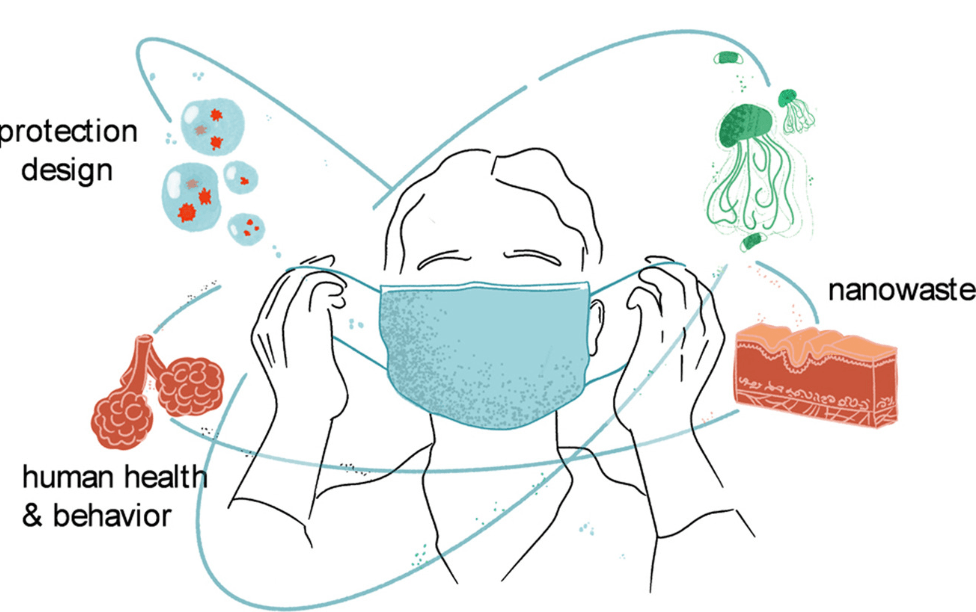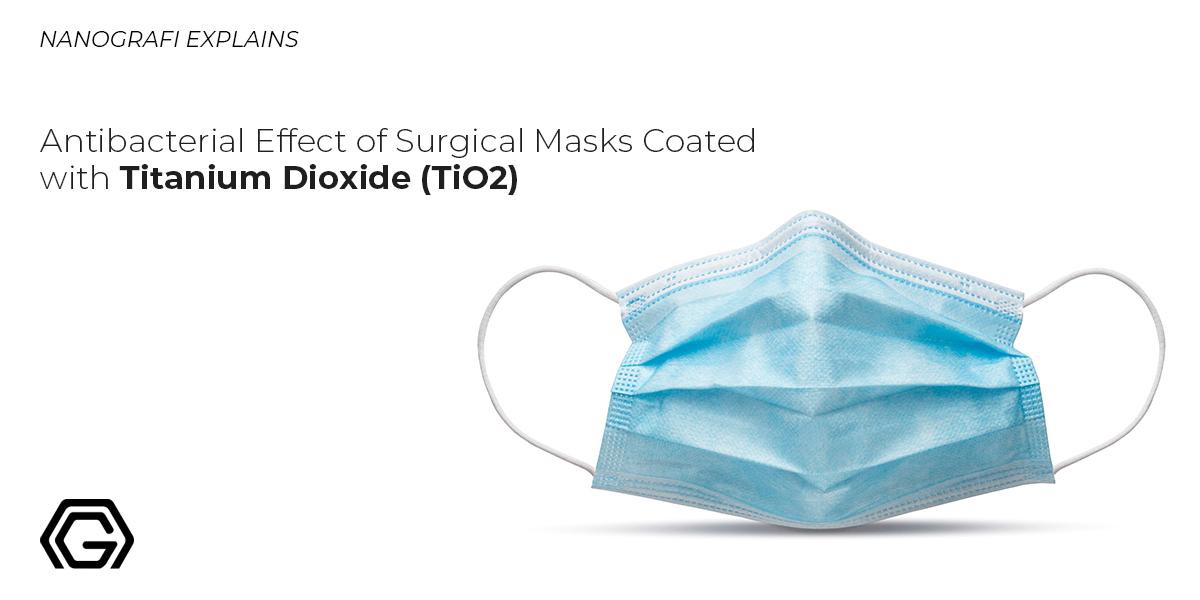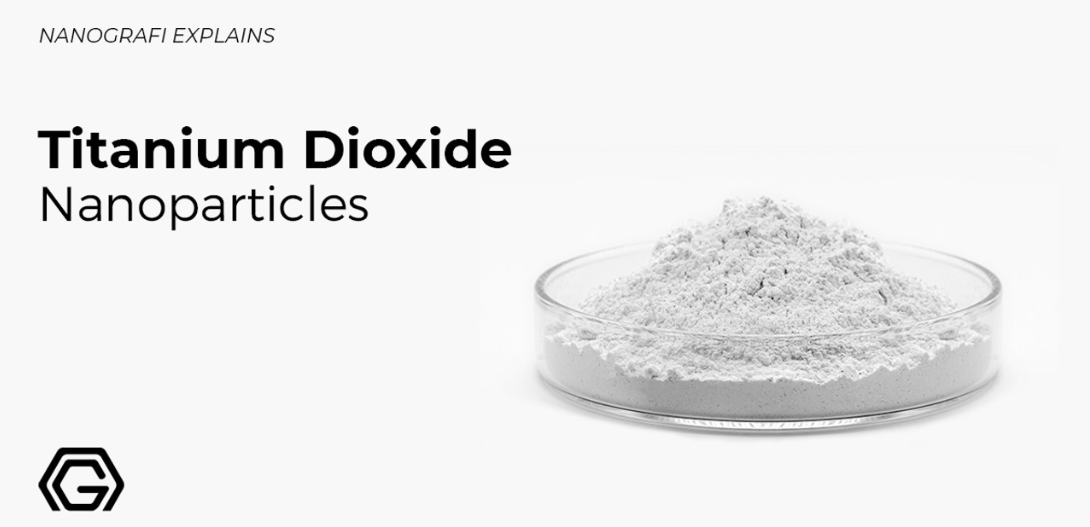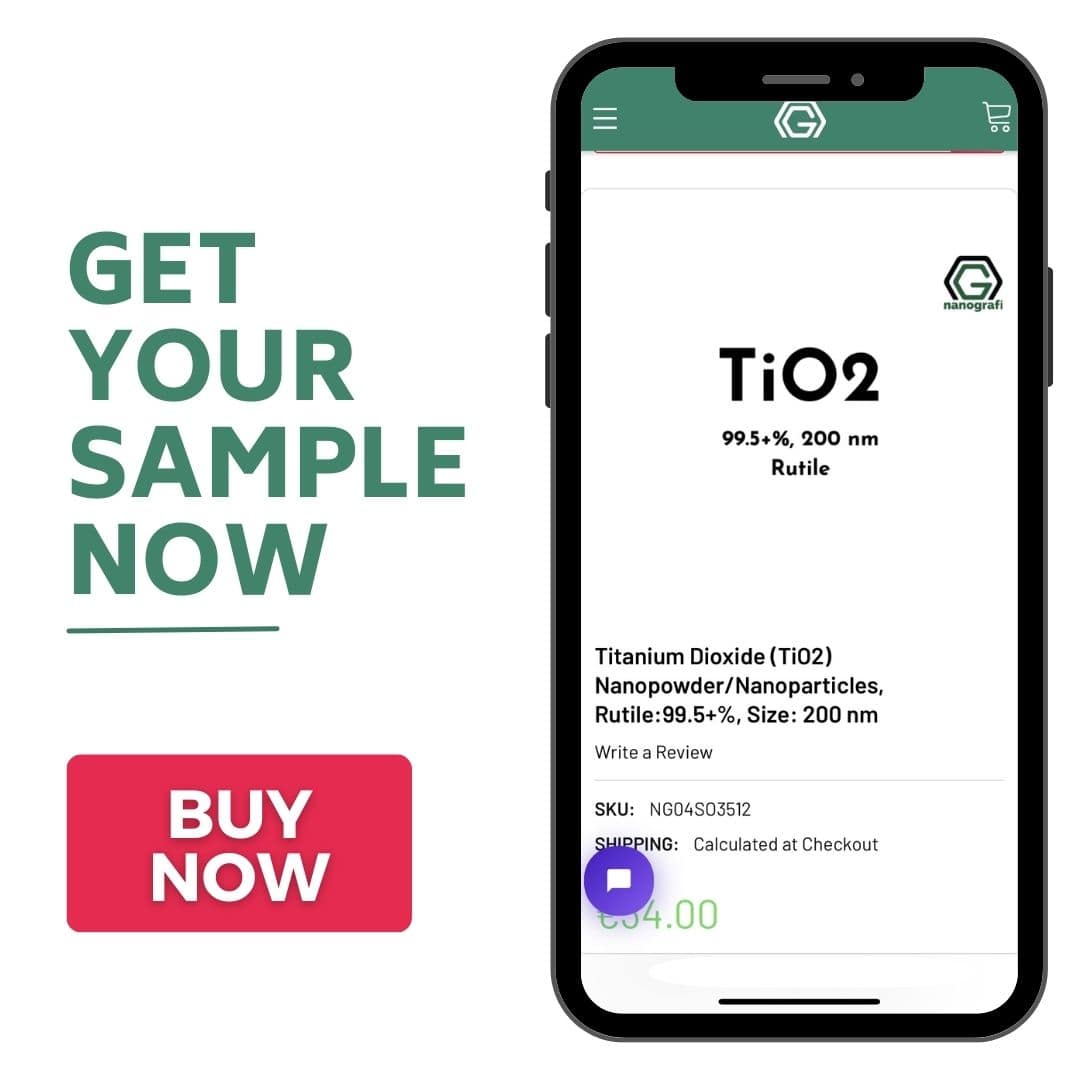Antibacterial Effect of Surgical Masks Coated with Titanium Dioxide (TiO2)
Titanium dioxide (TiO2), a widely used white pigment in cosmetics, paints, and sunscreens, is known for its photocatalytic properties. When exposed to ultraviolet (UV) light, TiO2 nanoparticles can generate reactive oxygen species (ROS) and exhibit antibacterial properties.
This unique characteristic has sparked interest in harnessing TiO2 as an antibacterial coating for surgical masks.This introduction sets the stage for a comprehensive exploration of the antibacterial effects of surgical masks coated with titanium dioxide. In this review, we will delve into the underlying mechanisms of TiO2-based antibacterial action, the various methods of applying TiO2 coatings to masks, and the potential implications for infection control in healthcare and public settings. Create sustainable and eco-friendly surgical masks for infection control and prevention with Titanium Dioxide (TiO2) products. Access Nanografi's products now!
Introduction
In recent years, the global community has witnessed the emergence and rapid spread of infectious diseases, highlighting the critical importance of infection control and prevention in healthcare settings and daily life. Surgical masks have long been a primary line of defense against respiratory infections, and the ongoing COVID-19 pandemic has further underscored their significance. While the primary function of surgical masks is to provide a physical barrier against the transmission of infectious agents, recent advancements in materials science and nanotechnology have opened up new avenues for enhancing their efficacy.
The primary objectives of this review are as follows:
1. To elucidate the mechanism by which titanium dioxide nanoparticles exhibit antibacterial properties and how this property can be leveraged in surgical masks.
2. To provide an overview of the different methods used for incorporating titanium dioxide into mask materials.
3. To review and analyze existing research on the antibacterial effectiveness of TiO2-coated surgical masks against various pathogens, including bacteria and viruses.
4. To discuss the potential benefits and challenges associated with the widespread use of TiO2-coated surgical masks in healthcare facilities and general public settings.
5. To offer insights into future research directions and the practical implications of this technology in the context of infection control and prevention.
As we continue to face the threat of infectious diseases and the ongoing need for effective preventive measures, the investigation of innovative technologies like TiO2-coated surgical masks is pivotal in augmenting our ability to safeguard public health. This review aims to contribute to a deeper understanding of the antibacterial effects of such masks and their potential role in mitigating the spread of infectious agents.
Titanium Dioxide (TiO2) Overview
Titanium dioxide (TiO2) is an inorganic compound known for its versatility and wide-ranging applications. It is commonly used as a white pigment in products like paints, plastics, paper, and cosmetics due to its excellent opacity and brightness. TiO2 is also utilized in sunscreens and skincare products as a UV filter to protect the skin from harmful UV radiation. Its photocatalytic properties make it useful for catalyzing chemical reactions when exposed to ultraviolet light, finding applications in air and water purification. Additionally, TiO2 is used in coatings, ceramics, food additives, and pharmaceuticals, contributing to its significance in various industries.
Why Titanium Dioxide?
Titanium dioxide (TiO2) exhibits antibacterial properties due to its photocatalytic activity. When exposed to ultraviolet (UV) light, TiO2 generates reactive oxygen species (ROS), including superoxide radicals and hydroxyl radicals. These ROS are highly reactive and can damage bacterial cell membranes, proteins, and DNA, ultimately leading to the death of various bacteria. TiO2's broad-spectrum antibacterial effect makes it promising for various applications, including self-cleaning surfaces. However, the practical application of TiO2 in masks or coatings depends on factors like UV light intensity, TiO2 nanoparticle concentration, and the presence of organic matter. Ongoing research aims to optimize TiO2-based antibacterial solutions while understanding their limitations for effective infection control.
Process of Coating Surgical Masks with Titanium Dioxide
Coating surgical masks with titanium dioxide (TiO2) involves a multi-step process to achieve an effective and uniform application of TiO2 nanoparticles onto the mask material. Key steps include selecting the appropriate TiO2 nanoparticles, preparing a TiO2 suspension, ensuring the cleanliness of the mask material, applying TiO2 using methods like dip-coating or spray-coating, and then drying and curing the mask to fix the TiO2 nanoparticles. Quality control checks are essential to verify uniform coating, and once confirmed, the TiO2-coated surgical masks can be packaged and distributed. The effectiveness of these masks depends on factors like nanoparticle concentration, coating uniformity, and exposure to ultraviolet (UV) light for activating TiO2's photocatalytic properties. Safety measures are crucial during production to protect workers from nanoparticle exposure. Researchers and manufacturers are continually working to optimize the antibacterial and antiviral properties of TiO2-coated masks.

Figure 1. Face masks and nanotechnology.
Studies and Findings on TiO2-coated Surgical Masks
Studies on TiO2-coated surgical masks have revealed promising findings regarding their antibacterial and antiviral effectiveness. These studies have shown that TiO2-coated masks can inhibit the growth of common bacteria and inactivate viruses when exposed to UV light. The research has also indicated potential benefits in reducing the spread of respiratory viruses. Additionally, TiO2-coated masks exhibit self-cleaning properties, breaking down organic matter. However, practical application depends on factors like coating quality, UV exposure, and the presence of organic materials. Continued research and development are essential to optimize these masks and fully understand their performance under real-world conditions.
Read our blog post on Top-Level Barrier Nano Coatings Against UV and NIR Radiation.
Benefits Beyond Antibacterial Properties of TiO2-Coated Surgical Masks
TiO2-coated surgical masks offer benefits beyond their antibacterial properties. These masks have demonstrated antiviral activity, self-cleaning capabilities, and long-lasting effects, reducing the need for frequent mask replacements. They also hold environmental advantages by potentially reducing mask waste. TiO2-coated masks enhance user comfort, have versatility in different settings, can reduce cross-contamination in healthcare, and contribute to public health by mitigating the spread of infectious agents, particularly during pandemics. However, ongoing research and development are needed to optimize their performance and address practical considerations such as the requirement for UV light exposure.
Potential Concerns and Limitations
TiO2-coated surgical masks offer numerous advantages, including antibacterial and antiviral properties, self-cleaning capabilities, and environmental benefits. However, they also come with potential concerns and limitations. These include dependency on UV light for activation, interference from organic matter, variations in real-world conditions, safety considerations, the need for quality and durability, environmental impact, cost implications, regulatory approval, user acceptance, and pathogen specificity. Addressing these issues through research, development, and safety measures is crucial to maximize the effectiveness and acceptance of TiO2-coated masks in various settings.
For detailed information about Titanium Dioxide (TiO2) nanoparticles, read our blog post.
Comparing with Other Antibacterial Coatings
TiO2-coated surgical masks offer distinct advantages when compared to other antibacterial coatings. They exhibit a broad spectrum of antimicrobial activity, including both antibacterial and antiviral effects. TiO2 coatings also provide self-cleaning properties, making them versatile for infection control and long-lasting use. Comparatively, other coatings like silver nanoparticles, copper, zinc oxide, graphene oxide, and hydrophobic coatings have specific mechanisms of action and may be more focused on antibacterial properties, with limited antiviral effects. The choice of coating depends on the specific requirements and the type of microorganisms to be addressed. TiO2 coatings offer a compelling solution with potential for enhanced infection control. However, practical factors like UV light exposure and safety should be considered during implementation.
Future Directions and Innovation
Future directions and innovations in TiO2-coated surgical masks are promising and may include advancements in photocatalysis, tailored coatings for specific pathogens, integration of sensors, eco-friendly formulations, safety improvements, regulatory standards, real-world testing, consumer adoption, integration with other technologies, global implementation, collaborative research, and sustainability. These developments are aimed at optimizing TiO2-coated masks for enhanced infection control and expanding their practical use. As research and innovation progress, TiO2-coated masks are likely to play a significant role in mitigating the spread of infectious agents in various settings.
Conclusion
In conclusion, TiO2-coated surgical masks represent an exciting and evolving frontier in infection control and prevention. These masks have demonstrated significant potential, offering not only antibacterial and antiviral properties but also self-cleaning capabilities and a broader spectrum of antimicrobial activity compared to some alternative coatings. While their effectiveness depends on factors like UV light exposure and organic matter interference, ongoing research and innovation are poised to address these challenges. The future of TiO2-coated masks holds promise for groundbreaking advancements. Researchers are actively working to enhance photocatalysis, develop tailored coatings for specific pathogens, integrate sensors for real-time monitoring, and ensure the safety of wearers and production workers. Regulatory standards, education, and global accessibility will play critical roles in the widespread adoption and implementation of these innovative masks.
Moreover, the sustainability of TiO2-coated masks and their eco-friendliness will be integral, aligning with global environmental concerns and responsible manufacturing and disposal practices. Collaboration across disciplines, including scientists, engineers, and healthcare professionals, will foster creativity and drive innovation. As the world grapples with infectious disease outbreaks and the need for effective preventive measures, TiO2-coated surgical masks have the potential to revolutionize infection control in healthcare and public settings. They offer a multifaceted solution that addresses not only bacterial and viral threats but also environmental and sustainability concerns. The path forward for TiO2-coated masks is one of ongoing research, innovation, and collaboration, as we work to harness their full potential in safeguarding public health and ensuring a safer, more resilient future in the face of infectious diseases. We are dedicated to developing and producing products that align with our mission for a cleaner and more sustainable energy future.
Step into the future with Nanografi, visit our website to learn more.
References
Ahmed, O. B., & Alamro, T. (2022). Evaluation of the antibacterial activities of face masks coated with titanium dioxide nanoparticles. Scientific Reports 2022 12:1, 12(1), 1–7. https://doi.org/10.1038/s41598-022-23615-w
Li, Y., Leung, P., Yao, L., Song, Q. W., & Newton, E. (2006). Antimicrobial effect of surgical masks coated with nanoparticles. Journal of Hospital Infection, 62(1), 58–63. https://doi.org/10.1016/j.jhin.2005.04.015
Nano Coatings: The Ultimate Barrier for UV and NIR Radiation - Nanografi - Nanografi Nano Technology. (n.d.). Retrieved January 16, 2024, from https://nanografi.com/blog/nano-coatings-the-ultimate-barrier-for-uv-and-nir-radiation-nanografi/
Rutile and Anatase TiO2 Nanoparticles and Applications - Nanografi Nano Technology. (n.d.). Retrieved January 16, 2024, from https://nanografi.com/blog/differences-between-rutile-and-anatase-tio2-nanoparticles-and-their-applications/
Titanium Dioxide Reshaping the Field of the Cosmetic Industry - Nanografi - Nanografi Nano Technology. (n.d.). Retrieved January 16, 2024, from https://nanografi.com/blog/titanium-dioxide-reshaping-the-field-of-the-cosmetic-industry-nanografi-/
Titanium Oxide Nanopowder/Nanoparticles Specifications - Nanografi Nano Technology. (n.d.). Retrieved January 16, 2024, from https://nanografi.com/blog/titanium-oxide-nanopowdernanoparticles-specifications/
Palmieri, V., De Maio, F., De Spirito, M., & Papi, M. (2021). Face masks and nanotechnology: Keep the blue side up. Nano Today, 37, 101077. https://doi.org/10.1016/J.NANTOD.2021.101077
Recent Posts
-
Advanced Materials for Unmanned Aerial Vehicle (UAV) Protection Against Laser
Consider a UAV on a critical mission, rendered inoperative by a sudden laser attack. With the increa …26th Jul 2024 -
Simulation and Modeling of Material Properties
Our world is composed of a dazzling array of materials, each with its own unique properties that dic …19th Jul 2024 -
Advanced Coatings for Superior Corrosion and Wear Resistance
Corrosion and wear pose significant challenges across various industries, leading to substantial eco …12th Jul 2024







